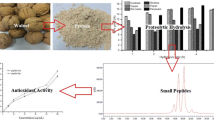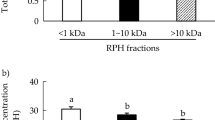Abstract
Rapeseed protein hydrolysates (RPH) were obtained by enzymatic hydrolysis of rapeseed protein using Alcalase 2.4 L FG. The degree of hydrolysis (DH) of RPH was about 25% using pH-stat method. The antioxidant activities of RPH were investigated by employing several in vitro assay, including the 1,1-diphenyl-2-picrylhydrazyl (DPPH)/superoxide/hydroxyl radical scavenging assays, and reducing power assay. RPH showed scavenging activity against free radicals such as DPPH, superoxide, and hydroxyl radicals. The radical scavenging effect was in a dose-dependent manner, and the EC50 values for DPPH, superoxide, and hydroxyl radicals were found to be 0.71, 1.05, and 4.92 mg/mL, respectively. In addition, the RPH also exhibited notable reducing power, which was 0.51 at 2.00 mg/mL. The data obtained by in vitro systems obviously established the antioxidant potency of RPH. Combined with the results of the amino acid profiles, RPH were believed to have high nutritive value in addition to antioxidant activities.





Similar content being viewed by others
References
Adler-Nissen, J. (1982). Limited enzymatic degradation of proteins: a new approach in the industrial application of hydrolases. Journal of Chemical Technology & Biotechnology., 32, 138–156.
Ali, B., Mohamed, H., Rafik, B., Imen, L., Yosra, T. E., & Moncef, N. (2009). Antioxidant and free radical-scavenging activities of smooth hound (Mustelus mustelus) muscle protein hydrolysates obtained by gastrointestinal proteases. Food Chemistry, 114, 1198–1205. doi:10.1016/j.foodchem.2008.10.075.
Aruoma, O. I. (1998). Free radicals oxidative stress and antioxidants in human health and disease. Journal of the American Oil Chemists' Society, 75, 199–211.
Avila-Sosa, R., Gastélum-Franco, M. G., Camacho-Dávila, A., Torres-Muñoz, J. V., Nevárez-Moorillón, G. V. (2009). Extracts of Mexican oregano (Lippia berlandieri Schauer) with antioxidant and antimicrobial activity. Food Bioprocess Technology. doi:10.1007/s11947-008-0085-7.
Berot, S., Compoint, J. P., Larre, C., Malabat, C., & Gueguen, J. (2005). Large scale purification of rapeseed proteins (Brassica napus L.). Journal of Chromatography. B, Analytical Technologies in the Biomedical and Life Sciences, 818, 35–42. doi:10.1016/j.jchromb.2004.08.001.
Cao, W. H., Zhang, C. H., Hong, P. Z., Ji, H. W., Hao, J. M., & Zhang, J. (2009). Autolysis of shrimp head by gradual temperature and nutritional quality of the resulting hydrolysate. Food Science and Technology, 42, 244–249.
Chabanon, G., Chevalot, I., Framboisier, X., Chenu, S., & Marc, I. (2007). Hydrolysis of rapeseed protein isolates: Kinetics, characterization and functional properties of hydrolysates. Process Biochemistry, 42, 1419–1428. doi:10.1016/j.procbio.2007.07.009.
Chen, H. M., Muramoto, K., Yamauchi, F., & Nokihara, K. (1996). Antioxidant activity of designed peptides based on the antioxidative peptide isolated from digests of a soybean protein. Journal of Agricultural and Food Chemistry, 44, 2619–2623. doi:10.1021/jf950833m.
Chen, H. M., Muramoto, K., Yamauchi, F., & Kenshiro, F. (1998). Antioxidative properties of histidine-containing peptides designed from peptide fragments found in the digests of a soybean protein. Journal of Agricultural and Food Chemistry, 46, 49–53. doi:10.1021/jf970649w.
Chiang, W. D., Shih, C. J., & Chu, Y. H. (1999). Functional properties of soy protein hydrolysate produced from a continuous membrane reactor system. Food Chemistry, 65, 189–194. doi:10.1016/S0308-8146(98)00193-9.
Clemente, A. (2000). Enzymatic protein hydrolysates in human nutrition. Trends in Food Science & Technology, 11, 254–262. doi:10.1016/S0924-2244(01)00007-3.
Cumby, N., Zhong, Y., Naczk, M., & Shahidi, F. (2008). Antioxidant activity and water-holding capacity of canola protein hydrolysates. Food Chemistry, 109, 144–148. doi:10.1016/j.foodchem.2007.12.039.
Dorman, H. J. D., Peltoketo, A., Hiltunen, R., & Tikkanen, M. J. (2003). Characterization of the antioxidant properties of deodorised aqueous extracts from selected Lamiaceae herbs. Food Chemistry, 83, 255–262. doi:10.1016/S0308-8146(03)00088-8.
Duh, P. D. (1998). Antioxidant activity of burdock (Arctium lappa Linne): Its scavenging effect on free radical and active oxygen. Journal of the American Oil Chemists’ Society, 75, 455–465.
FAO/WHO. (1991). Protein quality evaluation. Rome, Italy: Food and Agricultural Organisation of the United Nations.
Halliwell, B., Gutteridge, J. M. C., & Aruoma, O. I. (1987). The deoxyribose method: a simple ‘test tube’ assay for determination of rate constants for reactions of hydroxyl radicals. Analytical Biochemistry, 165, 215–219. doi:10.1016/0003-2697(87)90222-3.
Halliwell, B., Murcia, M. A., Chirico, S., & Arumoma, O. I. (1995). Free radicals and antioxidants in food and in vivo: What they do and how they work. CRC Critical Review Food Science & Nutrition, 35, 7–20.
Jao, C. L., & Ko, W. C. (2002). 1, 1-Diphenyl-2-picrylhydrazyl (DPPH) radical scavenging by protein Hydrolysates from tuna cooking juice. Fish Science, 68, 430–435. doi:10.1046/j.1444-2906.2002.00442.x.
Jayadeep, A., Singh, V., Rao, B. V. S., Srinivas, A., & Ali, S. Z. (2009). Effect of physical processing of commercial de-oiled rice bran on particle size distribution, and content of chemical and bio-functional components. Food Bioprocess Technology, 2, 57–67. doi:10.1007/s11947-008-0094-6.
Je, J., Qian, Z., Byun, H., & Kim, S. (2007). Purification and characterization of an antioxidant peptide obtained from tuna backbone protein by enzymatic hydrolysis. Process Biochemistry, 42, 840–846. doi:10.1016/j.procbio.2007.02.006.
Juntachote, T., & Berghofer, E. (2005). Antioxidative properties and stability of ethanolic extracts of holy basil and Galangal. Food Chemistry, 92, 193–202. doi:10.1016/j.foodchem.2004.04.044.
Kim, S. Y., Je, J. Y., & Kim, S. K. (2007). Purification and characterization of antioxidant peptide from hoki (Johnius belengerii) frame protein by gastrointestinal digestion. Journal of Nutritional Biochemistry, 18, 31–38. doi:10.1016/j.jnutbio.2006.02.006.
Leal, P. F., Maia, N. B., Carmello, Q. A. C., Catharino, R. R., Eberlin, M. N., & Meireles, M. A. A. (2008). Sweet basil (Ocimum basilicum) extracts obtained by supercritical fluid extraction (SFE): Global yields, chemical composition, antioxidant activity, and estimation of the cost of manufacturing. Food and Bioprocess Technology, 1, 326–338. doi:10.1007/s11947-007-0030-1.
Lee, J., Koo, N., & Min, D. B. (2004). Reactive oxygen species, aging, and antioxidant nutraceuticals. Comprehensive Reviews in Food Science and Food Safety, 3, 21–33. doi:10.1111/j.1541-4337.2004.tb00058.x.
Li, X. X., Han, L. J., & Chen, L. J. (2008). In vitro antioxidant activity of protein hydrolysates prepared from corn gluten meal. Journal of the Science of Food and Agriculture, 88, 1660–6. doi:10.1002/jsfa.3264.
Li, Y. H., Jiang, B., Zhang, T., Mu, W. M., Liu, J., & Qian, H. F. (2008). Antioxidant and free radical-scavenging activities of chickpea protein hydrolysate (CPH). Food Chemistry, 106, 444–50. doi:10.1016/j.foodchem.2007.04.067.
Macdonald, J., Galley, H. F., & Webster, N. R. (2003). Oxidative stress and gene expression in sepsis. British Journal of Anaesthesia, 90, 221–232. doi:10.1093/bja/aeg034.
Mahmoud, M. I., Malone, W. T., & Cordle, C. T. (1992). Enzymatic hydrolysis of casein: effect of degree of hydrolysis on antigenicity and physical properties. Journal of Food Science, 57, 1223–1229. doi:10.1111/j.1365-2621.1992.tb11304.x.
Marıa, D. C., Antonella, F., Iolanda, A., Rosa, C. B., Agustin, O., Adolfo, M. R., et al. (2007). In vitro release of angiotensin-converting enzyme inhibitors, peroxyl-radical scavengers and antibacterial compounds by enzymatic hydrolysis of glycated gluten. Journal of Cereal Science, 45, 327–334. doi:10.1016/j.jcs.2006.09.005.
Marklund, S., & Marklund, G. (1974). Involvement of the superoxide anion radical in the autoxidation of pyrogallal and a convenient assay for superoxide dismutase. European Journal of Biochemistry, 47, 469–474. doi:10.1111/j.1432-1033.1974.tb03714.x.
Moure, A., Dominguez, H., & Parajo, J. C. (2006). Antioxidant properties of ultrafiltration-recovered soy protein fractions from industrial effluents and their hydrolysates. Process Biochemistry, 41, 447–456. doi:10.1016/j.procbio.2005.07.014.
Ohlson, R., & Anjou, K. (1979). Rapeseed protein products. Journal of the American Oil Chemists' Society, 56, 431–437.
Oyaizu, M. (1988). Antioxidative activities of browning products of glucosamine fractionated by organic solvent and thin-layer chromatography. Journal of the Japanese Society for Food Science and Technology, 35, 771–775.
Parrado, J., Miramontes, E., Jover, M., Gutierrez, J. F., de Teran, L. C., & Bautista, J. (2006). Preparation of a rice bran enzymatic extract with potential use as functional food. Food Chemistry, 4, 742–748. doi:10.1016/j.foodchem.2005.07.016.
Pastuszewska, B., Jablecki, G., Swiech, E., Buraczewska, L., & Ochtabinska, A. (2000). Nutritional value of rapeseed meal containing lecithin gums precipitated with citric acid. Animal Feed Science and Technology, 86, 117–123. doi:10.1016/S0377-8401(00)00162-0.
Rajapakse, N., Mendis, E., Jung, W. K., Je, J. Y., & Kim, S. K. (2005). Purification of a radical scavenging peptide from fermented mussel sauce and its antioxidant properties. Food Research International, 38, 175–182. doi:10.1016/j.foodres.2004.10.002.
Randhir, R., & Shetty, K. (2005). Developmental stimulation of total phenolics and related antioxidant activity in light- and dark-germinated corn by natural elicitors. Process Biochemistry, 40, 1721–1732. doi:10.1016/j.procbio.2004.06.064.
Rekha, M. N., Yadav, A. R., Dharmesh, S., Chauhan, A. S., Ramteke, R. S. (2009). Evaluation of antioxidant properties of dry soup mix extracts containing dill (Anethum sowa L.) leaf. Food Bioprocess Technology. doi:10.1007/s11947-008-0123-5.
Saiga, A., Tanabe, S., & Nishimura, T. (2003). Antioxidant activity of peptides obtained from porcine myofibrillar proteins by protease treatment. Journal of Agricultural and Food Chemistry, 51, 3661–3667. doi:10.1021/jf021156g.
Schwenke, K. D. (1994). Rapeseed proteins. In B. J. F. Hudson (Ed.), New and developing sources of food proteins, pp. 281–306. London: Chapman and Hall.
Seabra, I. J., Braga, M. E. M., Batista, M. T. P., & de Sousa, H. C. “”(2009). Fractioned high pressure extraction of anthocyanins from elderberry (Sambucus nigra L.) pomace. Food Bioprocess Technology. doi:10.1007/s11947-008-0134-2.
Shimada, K., Fujikawa, K., Yahara, K., & Nakamura, T. (1992). Antioxidative properties of xanthan on the antioxidation of soybean oil in cyclodextrin emulsion. Journal of Agricultural and Food Chemistry, 40, 945–948. doi:10.1021/jf00018a005.
Vioque, J., Sánchez-Vioque, R., Clemente, A., Pedroche, J., Bautista, J., & Millan, F. (1999). Production and characterization of an extensive rapeseed protein hydrolysate. Journal of the American Oil Chemists' Society, 76, 819–823.
Vioque, J., Sánchez-Vioque, R., Clemente, A., Pedroche, J., & Millán, F. (2000). Partially hydrolysed rapeseed protein isolates with improved functional properties. Journal of the American Oil Chemists' Society, 77, 447–450.
Wang, J. S., Zhao, M. M., Zhao, Q. Z., & Jiang, Y. M. (2007). Antioxidant properties of papain hydrolysates of wheat gluten in different oxidation systems. Food Chemistry, 101, 1658–1663. doi:10.1016/j.foodchem.2006.04.024.
Xie, Z. J., Huang, J. R., Xu, X. M., & Jin, Z. Y. (2008). Antioxidant activity of peptides isolated from alfalfa leaf protein hydrolysate. Food Chemistry, 111, 370–376. doi:10.1016/j.foodchem.2008.03.078.
Yamamoto, N., & Kajimoto, G. (1980). Antioxidation effect of Gly-Gly-His on Cu(II)-catalyzed autooxidation and photosensitized oxidation of lipids. Agricultural and Biological Chemistry, 44, 2735–2736.
Yu, L., Haley, S., Perret, J., Harris, M., Wilson, J., & Qian, M. (2002). Free radical scavenging properties of wheat extracts. Journal of Agricultural and Food Chemistry, 50, 1619–1624. doi:10.1021/jf010964p.
Yumiko, Y. S., Yoshiko, W., Michael, S., & Andreas, W. (2006). Functional and bioactive properties of rapeseed protein concentrates and sensory analysis of food application with rapeseed protein concentrates. Food Science and Technology, 39, 503–512.
Yumiko, Y. S., Yoshiko, W., & Andreas, W. (2008). Chemical composition, functional properties, and bioactivities of rapeseed protein isolates. Food Chemistry, 107, 32–39. doi:10.1016/j.foodchem.2007.07.061.
Zhang, S. B., Wang, Z., & Xu, S. Y. (2007). Downstream processes for aqueous enzymatic extraction of rapeseed oil and protein hydrolysates. Journal of the American Oil Chemists' Society, 84, 693–700.
Zhang, S. B., Wang, Z., & Xu, S. Y. (2008). Antioxidant and antithrombotic activities of rapeseed peptides. Journal of the American Oil Chemists' Society, 85, 521–527.
Zhu, K. X., Zhou, H. M., & Qian, H. F. (2006). Antioxidant and free radical-scavenging activities of wheat germ protein Hydrolysates (WGPH) prepared with alcalase. Process Biochemistry, 41, 1296–1302. doi:10.1016/j.procbio.2005.12.029.
Acknowledgment
We gratefully acknowledge the financial support of the National Key-Technologies R&D Program (2006BAD05A12. 2006) of the 11th 5-year plan of the People’s Republic of China.
Author information
Authors and Affiliations
Corresponding author
Rights and permissions
About this article
Cite this article
Pan, M., Jiang, T.S. & Pan, J.L. Antioxidant Activities of Rapeseed Protein Hydrolysates. Food Bioprocess Technol 4, 1144–1152 (2011). https://doi.org/10.1007/s11947-009-0206-y
Received:
Accepted:
Published:
Issue Date:
DOI: https://doi.org/10.1007/s11947-009-0206-y




